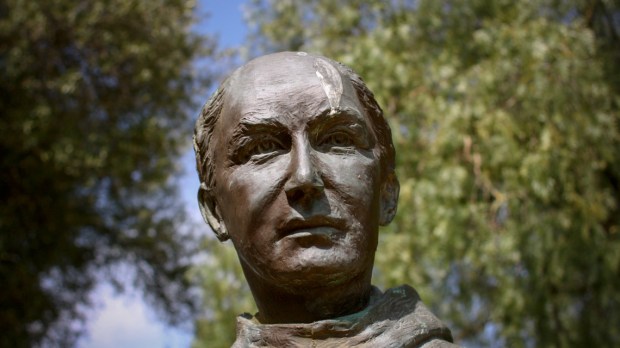Lenten Campaign 2025
This content is free of charge, as are all our articles.
Support us with a donation that is tax-deductible and enable us to continue to reach millions of readers.
At the height of Hispanic Heritage Month, California Gov. Gavin Newsom has signed legislation requiring that a statue of a Spanish saint be replaced with a monument commemorating the Native Americans he came to evangelize.
The statue of St. Junipero Serra, who founded many of the California missions in the southern part of the state, was toppled last year at the height of protests surrounding racial injustice. It was transferred from the capitol grounds in Sacramento to storage for safekeeping, but the state legislature voted recently to not return it to its former spot in Capitol Park, where it has stood since the 1960s.
Newsom on Friday signed Assembly Bill 338, which passed 66–2 in the Assembly and 28–2 in the Senate.
Earlier this month, Archbishops José H. Gomez of Los Angeles and Salvatore J. Cordileone of San Francisco wrote in a Wall Street Journal op-ed piece that the legislation slanders the “Apostle of California” and gets state history seriously wrong.
Assembly Bill 338 claims that St. Junipero oversaw a mission system that included “enslavement of both adults and children, mutilation, genocide, and assault on women.”
“While there is much to criticize from this period, no serious historian has ever made such outrageous claims about Serra or the mission system, the network of 21 communities that Franciscans established along the California coast to evangelize native people,” Gomez and Cordileone wrote.
The archbishops criticized California lawmakers for relying on “a single tendentious book written by journalist Elias Castillo,” A Cross of Thorns: The Enslavement of California’s Indians by the Spanish Missions.
“As leaders of the state’s two largest Catholic communities, we serve thousands of native Californians who trace their faith to ancestors who helped build the missions,” the archbishops wrote. “We understand the bitter history of native exploitation. But history can be complicated and facts matter.”
They described the saint, whom Pope Francis canonized in Washington, D.C., in 2015, as a “complex character,” but one who “defended indigenous people’s humanity, decried the abuse of indigenous women, and argued against imposing the death penalty on natives who had burned down a mission and murdered one of his friends.”
“Serra would surely approve of a new monument honoring the indigenous Californians he spent his life serving,” the archbishops conceded. St. Junipero traveled 2,000 miles to Mexico City when he was aged and infirm “to demand that authorities adopt a native bill of rights he had written,” they said.
“How we choose to remember the past shapes the people we hope to be in the future,” Archbishops Gomez and Cordileone wrote. “We can think of no better symbol for this multiethnic state committed to human dignity and equality than to place two statues at the California Capitol — one celebrating the living heritage of California’s indigenous peoples, another reflecting the faith and leadership of their defender St. Junipero Serra.”
Robert M. Senkewicz, history professor emeritus at Santa Clara University and author of Junipero Serra: California, Indians, and the Transformation of a Missionary, said in a 2015 interview with Catholic World Report that the mission system in California was set up to protect Native Californians from being enslaved.
“Serra and the Franciscans were concerned that the Spanish conquistadors would oppressively dominate” native peoples, he said. “They were concerned that Spanish ranchers, miners, and soldiers would round them up and work them to death. So they founded the missions as a place to convert and protect the Indians. Hence, Serra and the Franciscans saw their role as protecting the Indians.”

